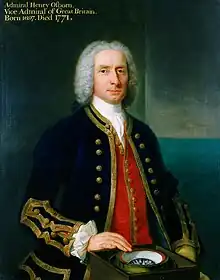Henry Osborn (Royal Navy officer)
Admiral Henry Osborn (baptized 27 August 1694 – 4 February 1771) was a British naval officer who served as Commodore-Governor of Newfoundland. He was a younger son of Sir John Osborn, 2nd Baronet.
Henry Osborn | |
|---|---|
 Portrait by Claude Arnulphy | |
| Born | 27 August 1694 Campton, Bedfordshire |
| Died | 4 February 1771 London |
| Allegiance | |
| Service/ | |
| Years of service | 1710–1771 |
| Rank | Admiral |
| Commands held | HMS Weazle HMS Squirrel Newfoundland station HMS Portland HMS Salisbury HMS Prince of Orange HMS Chichester HMS Princess Caroline Nore Command Leeward Islands Station Portsmouth Command Mediterranean Fleet |
| Battles/wars | |
Naval career
Osborn joined the Royal Navy as a volunteer in 1710.[1] He was promoted lieutenant in 1717, and his first command was HMS Squirrel in 1728.[1]
On 14 May 1729, Osborn was appointed the first commodore-governor of Newfoundland,[1] when Lord Vere Beauclerk, the naval commander of Newfoundland had declined.[2] He visited all of the notable places on the island and divided it into six districts. Within each of the districts he appointed magistrates and constables.[2] He served as Port Admiral at Portsmouth from 1756 to 1757.[3][1]
In 1757, he was promoted Admiral of the Blue and appointed Commander-in-Chief, Mediterranean Fleet.[1]
Battle of Cartagena
In late 1757 Osborn besieged the neutral port of Cartagena in Spain[1] where a French squadron designed to go to the relief of Louisbourg had taken shelter. While there he attacked a small French squadron under Michel-Ange Duquesne de Menneville which was coming to the aid of the trapped force. Two French ships were captured, including Duquesne's flagship and it indirectly led to the successful British capture of Louisbourg later that year. The battle helped to restore the Royal Navy's reputation following the failed attempt to relieve Minorca two years earlier which had led to Admiral Byng's execution.[4]
On 1 January 1763, he received the honorific post of Vice-Admiral of Great Britain.[5] He entered Parliament in late 1758 for Bedfordshire in a by-election, sitting until 1761.[1]
Notes
- Pearsall 2008.
- "Osborn, Henry (1694-1771): Governor, 1729-1730". Government House: The Governor of Newfoundland and Labrador. Newfoundland and Labrador Heritage Web Site Project. 30 October 2012 [2000].
- "Port admirals". History in Portsmouth. Archived from the original on 27 June 2015. Retrieved 4 May 2015.
- Rodger 2006, p. 274.
- "No. 10275". The London Gazette. 1 January 1763. p. 1.
References
- Pearsall, A. W. H. (January 2008) [2004]. "Osborn, Henry (bap. 1694, d. 1771)". Oxford Dictionary of National Biography (online ed.). Oxford University Press. doi:10.1093/ref:odnb/20878. (Subscription or UK public library membership required.) The first edition of this text is available at Wikisource: . Dictionary of National Biography. London: Smith, Elder & Co. 1885–1900.
- Rodger, N.A.M. (2006). Command of the Ocean: A Naval History of Britain, 1649-1815. Penguin Books.
Further reading
- Thompson, Frederic F. (1979). "Henry Osborn". In Halpenny, Francess G (ed.). Dictionary of Canadian Biography. Vol. IV (1771–1800) (online ed.). University of Toronto Press.
- Beatson, Robert (1807). A chronological register of both houses of the British Parliament. Vol. II.